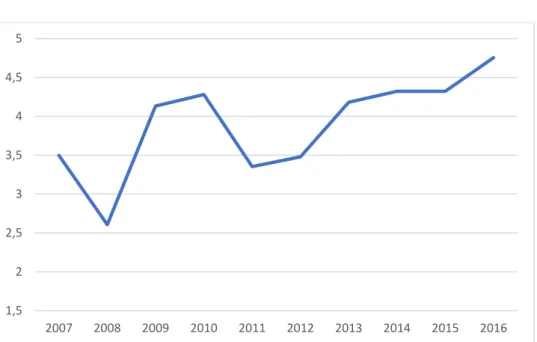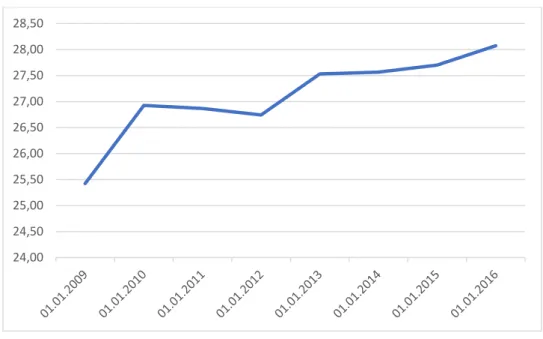The existing studies provide rather mixed evidence regarding the impact of regulatory and supervisory policies on banking sector performance and banks' immunity against various types of financial system contagions. More specific studies conducted to assess the possible effects of EU regulatory reforms on bank profitability, subsequent economic growth and credit conditions provide rather contradictory results. The purpose – the legislative proposals issued by the European regulatory authorities to address the shortcomings of the previously existing regulatory system, the economic interlinkages between regulatory reforms and the activities/profitability of banks.
The historical method was used to identify the events and causes of regulatory changes after the crisis. The prediction of the possible consequences of the reforms was based on the logical analysis method. Statistical analysis methods were used to evaluate the preliminary effects of the regulatory reforms.
Theoretical contribution of the study: the overall, holistic assessment of the regulatory approach of the EU authorities to tackle the malign crisis developments; Practical contribution of the research: The research paper gathers necessary information on the costs, potential risks and challenges faced by banking institutions in adopting the stricter banking regulations.
THEORETICAL ASPECTS OF BANKING REGULATION
The economic essence and role of banking regulation
One of the commonly cited arguments in the literature for bank regulation is the special status of banks, which they have because of their exceptional functions in the economy. This would lead to a double effort in the banking system or a waiver of supervision, which would inevitably lead to the problem of free-riding. Another argument for bank regulation stems from the need to correct market failures and mitigate the effects of the externalities resulting from potential bank failures.
Nevertheless, banks' responses in practice also result in some forms of market imperfections, as banks use the information asymmetry to their own advantage. Therefore, the market fails to provide the public good – the surveillance services – in sufficient quantities. The liquidity supply function is usually performed by central banks; they are also responsible for the supervision of the banks in a banking system.
Central bank supervision should ensure that banks' assets are properly deployed to support the liquidity transformation and liquidity provision functions of banks. The situation is further aggravated by the previously mentioned lack of transparency of the banks.
The main instruments of banking regulation
Some researchers argue that barriers to entry help increase the quality of credit institutions and largely contribute to the overall stability of a banking sector. 51 Some other researchers (e.g. S. Kendall) pointed out the destructive impact of increased capital requirements only under specific circumstances. Some researchers encourage the use of stricter activity restrictions under certain circumstances.
Another essential element of banking regulation is liquidity requirements as they perform one of the banks' key functions: asset transformation for further liquidity provision. One of the important tasks of the regulatory authorities is therefore to establish a certain prudent regulatory framework to counter the occurrence of banks. It is often argued that tighter liquidity regulation can effectively reduce the risk of bank runs and potential freezing of the interbank market.
The regulatory authorities should determine the corresponding limit, scope and conditions of insurance coverage to monitor the behavior of owners and savers. The regulatory measures we discussed earlier are the most widely used and the most essential for the smooth functioning of the banking system.
The international guidelines to the organization of banking regulation and supervision
An additional disadvantage of capital regulations was portfolio invariance – the calculation of risk of correspondent asset exposures separately, without considering the joint composition of the portfolio. A further limitation of the Basel II framework – the inability of supervisory authorities to issue early warning to insolvent and highly problematic banks, as they lack forward-looking risk measures in risk modeling that enable the identification of potential failures and systemic risk. The Basel Committee on Banking Supervision has begun work on a new version of the Basel Accord.
71 "Basel III: A Global regulatory framework for more resilient banks and banking systems": the BCBS from June 2011. 72 "Basel III: A Global regulatory framework for more resilient banks and banking systems": the BCBS from December 2010. 76 " Basel III: A global regulatory framework for more resilient banks and banking systems”: the BCBS as of December 2010 (rev. June 2011).
77 "Global systemically important banks: Updated assessment methodology and the higher loss absorbing requirement": the BCBS from July 2013. 79 "Basel III: A Global regulatory framework for more resilient banks and banking systems": the BCBS from December 2010 (rev. June 2011 ).
POST-CRISIS DEVELOPMENTS IN THE FIELD OF THE EU BANKING
Lessons from the crisis and need for reforms in the EU banking regulatory sector
Post-crisis changes to the European system of banking regulation and supervision
38 most of the financial assets in the euro area are owned by banks, shows their key role in the financial system. The following safety nets prevent widespread collapse of the financial intermediaries' intermediation services. The countercyclical capital buffer should have equaled the total risk exposure multiplied by the weighted average of the countercyclical buffer rates specified in CRD IV.
Each subsequent category had to increase the value of the buffer by 0.5% compared to the previous category. The buffer of the local financial institutions should have been equal to 2% of the risk-weighted assets. 105Directive 2013/36/EU of the European Parliament and of the Council of 26 June 2013 on access to the business of credit institutions and the prudential supervision of credit institutions and investment firms.
108 Based on this conclusion, the application of the leverage ratio as a binding measure started in January 2018. As was emphasized before, in the period of the crisis, banking institutions did not possess sufficient amounts of liquid assets. One of the main controversies about the CRD IV package is the treatment of sovereign risk.
Another important piece of post-crisis legislation that addresses the issue of financial stability in the banking sector is the Bank Recovery and Resolution Directive (BRRD). 113 Directive 2014/59/EU of the European Parliament and of the Council of 15 May 2014 establishing a framework for the recovery and resolution of credit institutions and investment firms. 114 Directive 2014/59/EU of the European Parliament and of the Council of 15 May 2014 establishing a framework for the recovery and resolution of credit institutions and investment firms.
Further rules that were supposed to improve the EU regulatory framework for shadow banking were brought about by MIFID and the supplementary regulation, published in the Official Journal in 2014. 118 Regulation (EU of the European Parliament and of the Council of July 2012 on OTC derivatives, central parties and trade repositories To complete the work, in 2010 the Commission proposed a more complete reformulation of the existing Directive.
The rationale and current layout of the Banking Union project
The creation of the European System of Financial Supervision consisting of three micro-prudential supervisory authorities (European Banking Authority (EBA), European Securities (ESMA) and Market Authority and European Insurance and Occupational Pensions Authority (EIOPA) deemed necessary for the promotion of the single rule book A decision to establish a full-fledged Banking Union in the euro area was postulated in the report of the President of the European Council, Herman Van Rompuy, in June 2012. This can be applied to the structure and way of functioning of the Banking Union in the EU.
The Single Supervisory Mechanism is the first pillar of the European Banking Union, which includes the European Central Bank, which is responsible for its operation, and the competent national supervisory authorities of the euro area. Most supervisory decisions are taken by ECB officials; national representatives deal primarily with the implementation of ECB acts. The second document of the legislative package on EMN refers to the tasks of the European Banking Authority.
The second document regulated the transfer and mutual distribution of the contributions within the separate fund. The work of the GAM is based on a central decision-making body, the Resolution Board, and a Single Resolution Fund. Several improvements need to be implemented to address the following shortcomings of the current SRM architecture.
The size of the common settlement fund should be increased to make it more credible as a power stabilization tool. As in the case of the SRM, the degree of political interference in specific bank resolution programs should be reduced. The third pillar of the architecture of the European banking union – European Deposit Insurance – is still under construction.
The first is that the credibility of a unified deposit insurance system without a state guarantee is impossible (tight fiscal consolidation within the EU member states would be necessary). 143 Communication to the European Parliament, the Council, the European Central Bank, the European Economic and Social Committee and the Committee of the Regions on the completion of the Banking Union, European Commission, Brussels. At the forefront of the regulatory agenda was the project of creating a banking union, which, despite significant progress, remains unfinished.
IMPACTS, FIRST RESULTS AND CONSEQUENCES OF THE REFORMS
The impact assessment of the EU banking reforms
The first results from the implementation of the reforms and the way forward
The unresolved issues and unintended consequences of EU banking regulatory

